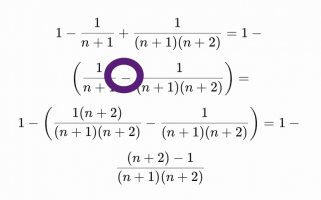Why was the term rearranged like that?
- Thread starter LazeFox
- Start date
Dr.Peterson
Elite Member
- Joined
- Nov 12, 2017
- Messages
- 16,826
If you're really asking "why", as in the title, we'd need to know the context to see the goal.View attachment 28536
How do I get this solution? I'm not sure as to what to do here
But for "how", as you ask here, they are just combining the fractions using a common denominator:
1−n+11+(n+1)(n+2)1=1−(n+11−(n+1)(n+2)1)=1−((n+1)(n+2)1(n+2)−(n+1)(n+2)1)=1−(n+1)(n+2)(n+2)−1
mikewill54
New member
- Joined
- Mar 7, 2016
- Messages
- 31
Why does the + become a - inbetween the two fractions?
Dr.Peterson
Elite Member
- Joined
- Nov 12, 2017
- Messages
- 16,826
Do you understand distribution? a−(b−c)=a−b+c. This is just the reverse of that.Why does the + become a - inbetween the two fractions?
Otis
Elite Member
- Joined
- Apr 22, 2015
- Messages
- 4,592
Hi Mike. There are different ways to simplify the given expression algebraically. Dr. Peterson chose to associate the two fractions and then subtract them as a group, but he could have used a different approach, instead. When doing math, there are many personal choices available.Why does the + become a - inbetween the two fractions?
By the way, the result in the op is not fully simplified. However, we can't say whether it ought to be, without any context.
?
mikewill54
New member
- Joined
- Mar 7, 2016
- Messages
- 31
Otis
Elite Member
- Joined
- Apr 22, 2015
- Messages
- 4,592
Your meaning is clear, Mike. I'd just pointed out that it's not necessary to start by changing that arithmetic operator. There are often many differing ways in beginning algebra to arrive at a particular result.I meant the following
Your meaning in that statement is not clear, Mike.I can see what you’ve don’t now.
"I can see what you have do not now"
?
AbdelRahmanShady
Junior Member
- Joined
- Jul 20, 2021
- Messages
- 123
The equation started with 1 -1/(n+1) + 1/(n+1)(n+2)
So it turns into 1 (-1/(n+1) )+ 1/(n+1)(n+2)
So the answer will be (1 - (n+2))/(n+1)(n+2)
So it turns into 1 (-1/(n+1) )+ 1/(n+1)(n+2)
So the answer will be (1 - (n+2))/(n+1)(n+2)
AbdelRahmanShady
Junior Member
- Joined
- Jul 20, 2021
- Messages
- 123
The equation started with 1 -1/(n+1) + 1/(n+1)(n+2)
So it turns into 1 +(-1/(n+1) )+ 1/(n+1)(n+2)
So the answer will be 1-(1 - (n+2))/(n+1)(n+2)
There was a mistake I did
So it turns into 1 +(-1/(n+1) )+ 1/(n+1)(n+2)
So the answer will be 1-(1 - (n+2))/(n+1)(n+2)
There was a mistake I did
AbdelRahmanShady
Junior Member
- Joined
- Jul 20, 2021
- Messages
- 123
Sorry again correction must be
The equation started with 1 -1/(n+1) + 1/(n+1)(n+2)
So it turns into 1 +(-1/(n+1) )+ 1/(n+1)(n+2)
So the answer will be 1+(1 - (n+2))/(n+1)(n+2)
The equation started with 1 -1/(n+1) + 1/(n+1)(n+2)
So it turns into 1 +(-1/(n+1) )+ 1/(n+1)(n+2)
So the answer will be 1+(1 - (n+2))/(n+1)(n+2)
lev888
Elite Member
- Joined
- Jan 16, 2018
- Messages
- 2,995
1-a+b = 1-(a-b)
Do you understand why?
AbdelRahmanShady
Junior Member
- Joined
- Jul 20, 2021
- Messages
- 123
Isn’t 1 - a + b = 1 + -a + b
How did you know he meant 1 -(a+b)
How did you know he meant 1 -(a+b)
lev888
Elite Member
- Joined
- Jan 16, 2018
- Messages
- 2,995
1 + -a + b is not a valid expression, please clarify what you mean.Isn’t 1 - a + b = 1 + -a + b
How did you know he meant 1 -(a+b)
Here's the explanation:
1 - a + b means we want to subtract a, then add b.
What if we want to take care of a and b first, then subtract the result from 1?
Would it be 1-(a+b)?
No. This means we are subtracting both a and b from 1, do you see it?
b is added to the total. Therefore it should be subtracted from the amount we are subtracting from 1: 1 - (a-b).
Another way:
1-a+b = 1 + (-1)a + b = 1 + (-1)a - (-1)b.
Factoring out (-1): 1 + (-1)(a - b) = 1 - (a - b).


